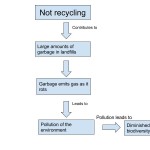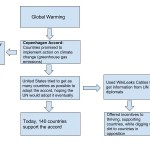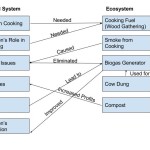- Throughout the module, human influence on biodiversity was discussed. In your hometown, how do the people affect biodiversity? Do they influence it in a positive way or a negative way? Write a 150-200 word paragraph explaining this.
- For part 2 of this assignment, create a system diagram that shows how an activity that you do influences biodiversity.
- Look up a current event relating to biodiversity. Summarize what you learned in a paragraph of 150-200 words.
Completing my assignment:
- My hometown is Mountaintop, Pennsylvania. Unfortunately, the people in Mountaintop affect biodiversity negatively. When I thought about this question, a lot of negative actions came to mind that Mountaintop does. For example, in my hometown there is an industrial park. In the past, the industrial park did not dispose of the waste properly and it polluted the water supply in certain parts of our town. Citizens and the surrounding habitats were affected by this pollution. Water was not the only thing that is polluted in Mountaintop though. Everyone in Mountaintop drives almost everywhere they need to go. Although everything is close together and within walking distance, no one chooses to walk, which only hurts the environment because of the CO2 polluting the air. Along with pollution, deforestation also impacts biodiversity in Mountaintop. In recent years, Mountaintop has cut down a lot of the trees in the town in order to develop new buildings. Overall, all of these actions that my hometown affects biodiversity negatively.
In this video, titled, “Chile’s most biodiverse park threatened by climate change,” I learned about how the climate change is impacting Omora Park on Chile’s Navarino Island. The video stated that this park is home to the largest variety of mosses and lichens in the world. There are very different ecosystems that are able to exist in the area. It was stated in the video that there are very dry ecosystems in the east of that region and very wet ecosystems in the west portion of that ecosystem. This area is by the Cape Horn region, which has not been industrialized, and the surrounding water is extremely clean. However, the forests in Omora Park have become very efficient at absorbing CO2. Since the region is so close to the South Pole, it has been extremely affected by the climate change. Because of this, the species in the area need to move to cooler temperatures, but they have nowhere to go. Today, Omora Park is being monitored to in order to monitor the impact of climate change on a smaller scale.




